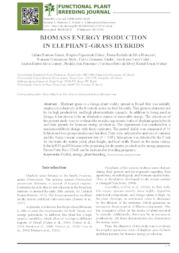Biomass energy production in elephant-grass hybrids.
Biomass energy production in elephant-grass hybrids.
Author(s): SOUSA, L. B.; DAHER, R. F.; MENEZES, B. R. da S.; STIDA, W. F.; TARDIN, F. D.; VIDAL, A. K. F.; GOMES, A. B. S.; PONCIANO, N. J.; SILVA, V. B. da; FREITAS, R. S.
Summary: Elephant grass is a forage plant widely spread in Brazil that was initially employed exclusively in the livestock sector as feed for cattle. This grass is characterized by its high productivity and high photosynthetic capacity. In addition to being used as forage, it has shown to be an alternative source of renewable energy. The objectives of the present study were to evaluate the morpho-agronomic traits of elephant grass hybrids and their parents for biomass energy production. The experiment was conducted in a randomized-block design with three replicates. The partial diallel was composed of 16 hybrids and two groups (males and females). Data were subjected to analysis of variance and the Tukey?s mean comparison test (P < 0.05). Interaction was detected by the F test for the traits dry matter yield, plant height, and leaf width. Based on the mean values, hybrids H11 and H14 seem to be promising for dry matter production for energy purposes. Parent Porto Rico 534-B can be indicated in breeding programs.
Publication year: 2019
Types of publication: Journal article
Unit: Embrapa Maize & Sorghum
Keywords: Capim Elefante, Melhoramento Vegetal, Pennisetum Purpureum
Observation
Some of Embrapa's publications are published as ePub files. To read them, use or download one of the following free software options to your computer or mobile device. Android: Google Play Books; IOS: iBooks; Windows and Linux: Calibre.
Access other publications
Access the Agricultural Research Database (BDPA) to consult Embrapa's full library collection and records.
Visit Embrapa Bookstore to purchase books and other publications sold by Embrapa.

